Synthesis of Nanocrystalline Mg-Al Hydrotalcites in the Presence of Starch—the Effect on Structure and Composition
Abstract
1. Introduction
2. Materials and Methods
3. Results and Discussion
4. Conclusions
Author Contributions
Funding
Conflicts of Interest
References
- Cavani, F.; Trifirò, F.; Vaccari, A. Hydrotalcite-type anionic clays: preparation, properties and applications. Catal. Today 1991, 11, 173–301. [Google Scholar] [CrossRef]
- Del Hoyo, C. Layered double hydroxides and human health: An overview. Appl. Clay Sci. 2007, 36, 103–121. [Google Scholar] [CrossRef]
- Costa, F.R.; Saphiannikova, M.; Wagenknecht, U.; Heinrich, G. Layered Double Hydroxide Based Polymer Nanocomposites. In Wax Crystal Control Nanocomposites Stimuli-Responsive Polymers. Advances in Polymer Science; Springer: Berlin/Heidelberg, Germany, 2008; Volume 210, pp. 101–168. [Google Scholar]
- Rives, V.; del Arco, M.; Martín, C. Layered double hydroxides as drug carriers and for controlled release of non-steroidal antiinflammatory drugs (NSAIDs): A review. J. Control. Release 2013, 169, 28–39. [Google Scholar] [CrossRef]
- Mohapatra, L.; Parida, K. A review on the recent progress, challenges and perspective of layered double hydroxides as promising photocatalysts. J. Mater. Chem. A 2016, 4, 10744–10766. [Google Scholar] [CrossRef]
- Takehira, K. Recent development of layered double hydroxide-derived catalysts − Rehydration, reconstitution, and supporting, aiming at commercial application. Appl. Clay Sci. 2017, 136, 112–141. [Google Scholar] [CrossRef]
- Prevot, V.; Tokudome, Y. 3D hierarchical and porous layered double hydroxide structures: An overview of synthesis methods and applications. J. Mater. Sci. 2017, 52, 11229–11250. [Google Scholar] [CrossRef]
- Ötvös, S.B.; Pálinkó, I.; Fülöp, F. Catalytic use of layered materials for fine chemical syntheses. Catal. Sci. Technol. 2019, 9, 47–60. [Google Scholar] [CrossRef]
- Yang, Z.; Wei, J.; Zeng, G.; Zhang, H.; Tan, X.; Tan, X.; Ma, C.; Li, X.; Li, Z.; Zhang, C. A review on strategies to LDH-based materials to improve adsorption capacity and photoreduction efficiency for CO2. Coord. Chem. Rev. 2019, 386, 154–182. [Google Scholar] [CrossRef]
- Zhao, Y.; Wei, M.; Lu, J.; Wang, Z.L.; Duan, X. Biotemplated hierarchical nanostructure of layered double hydroxides with improved photocatalysis performance. ACS Nano 2009, 3, 4009–4016. [Google Scholar] [CrossRef] [PubMed]
- Zhang, T.; Zhou, Y.; Bu, X.; Xue, J.; Hu, J.; Wang, Y.; Zhang, M. Bio-inspired fabrication of hierarchically porous Mg–Al composites for enhanced BSA adsorption properties. Micropor. Mesopor. Mater. 2014, 188, 37–45. [Google Scholar] [CrossRef]
- Zhang, T.; Mei, Y.; Zhou, Z.; Bu, X.; Wang, Y.; Li, Q.; Yang, X. Template-controlled fabrication of hierarchical porous Zn–Al composites with tunable micro/nanostructures and chemical compositions. Cryst. Eng. Comm. 2014, 16, 1793–1801. [Google Scholar] [CrossRef]
- Li, J.; Zhang, N.; Ng, D.H.L. Synthesis of a 3D hierarchical structure of γ-AlO(OH)/Mg–Al-LDH/C and its performance in organic dyes and antibiotics adsorption. J. Mater. Chem. A 2015, 3, 21106–21115. [Google Scholar] [CrossRef]
- Gao, L.; Li, Q.; Hu, X.; Wang, X.; Song, H.; Yan, L.; Xiao, H. One-pot synthesis of biomorphic Mg-Al mixed metal oxides with enhanced methyl orange adsorption properties. Appl. Clay Sci. 2016, 126, 299–305. [Google Scholar] [CrossRef]
- Wang, R.; Li, Q.; Duan, N.; Zhang, T.; Lu, H. Preparation of biomorphic Ni–Al LDHs using cotton from discarded T–shirt as a template and the adsorption capability for Congo red. Res. Chem. Intermed. 2015, 41, 7899–7914. [Google Scholar] [CrossRef]
- Wang, Y.; Li, Q.; Bo, L.; Wang, X.; Zhang, T.; Li, S.; Ren, P.; Wei, G. Synthesis and oil absorption of biomorphic MgAl layered double oxide/acrylic ester resin by suspension polymerization. Chem. Eng. J. 2016, 284, 989–994. [Google Scholar] [CrossRef]
- Yu, J.; Lu, L.; Li, J.; Song, P. Biotemplated hierarchical porous-structure of ZnAl-LDH/ZnCo2O4 composites with enhanced adsorption and photocatalytic performance. RSC Adv. 2016, 6, 12797–12808. [Google Scholar] [CrossRef]
- Sobhana, S.S.L.; Bogati, D.R.; Reza, M.; Gustafsson, J.; Fardim, P. Cellulose biotemplates for layered double hydroxides networks. Micropor. Mesopor. Mater. 2016, 225, 66–73. [Google Scholar] [CrossRef]
- Dong, J.; Zhu, T.; Li, H.; Sun, H.; Wang, Y.; Niu, L.; Wen, X.; Bai, G. Biotemplate-Assisted Synthesis of Layered Double Oxides Confining Ultrafine Ni Nanoparticles as a Stable Catalyst for Phenol Hydrogenation. Ind. Eng. Chem. Res. 2019, 58, 14688–14694. [Google Scholar] [CrossRef]
- Coelho, A.; Perrone, O.M.; Gomes, E.; Da-Silva, R.; Thoméo, J.C.; Boscolo, M. Mixed metal oxides from sucrose and cornstarch templated hydrotalcite-like LDHs as catalysts for ethyl biodiesel synthesis. Appl. Catal. A 2017, 532, 32–39. [Google Scholar] [CrossRef]
- Tao, X.; Liu, D.; Cong, W.; Huang, L. Controllable synthesis of starch-modified ZnMgAl-LDHs for adsorption property improvement. Appl. Surf. Sci. 2018, 457, 572–579. [Google Scholar] [CrossRef]
- Ruiz-Hitzky, E.; Darder, M.; Aranda, P. Functional biopolymer nanocomposites based on layered solids. J. Mater. Chem. 2005, 15, 3650–3662. [Google Scholar] [CrossRef]
- Zhang, G.; Shen, X.; Yang, Y. Facile synthesis of monodisperse porous ZnO spheres by a soluble starch-assisted method and their photocatalytic activity. J. Phys. Chem. C 2011, 115, 7145–7152. [Google Scholar] [CrossRef]
- Ramimoghadam, D.; Hussein, M.Z.B.; Taufiq-Yap, Y.H. Hydrothermal synthesis of zinc oxide nanoparticles using rice as soft biotemplate. Chem. Cent. J. 2013, 7, 136. [Google Scholar] [CrossRef] [PubMed]
- Ferreira, N.S.; Angélica, R.S.; Marques, V.B.; de Lima, C.C.O.; Silva, M.S. Cassava-starch-assisted sol–gel synthesis of CeO2 nanoparticles. Mater. Lett. 2016, 165, 139–142. [Google Scholar] [CrossRef]
- Ramasami, A.K.; Reddy, M.V.; Nithyadharseni, M.V.P.; Vhowdari, B.V.R.; Balakrishna, G.R. Gel-combustion synthesized vanadium pentoxide nanowire clusters for rechargeable lithium batteries. J. Alloy. Compd. 2017, 695, 850–858. [Google Scholar] [CrossRef]
- Hu, G.; Wang, N.; O’Hare, D.; Davis, J. Synthesis of magnesium aluminium layered double hydroxides in reverse microemulsions. J. Mater. Chem. 2007, 17, 2257–2266. [Google Scholar] [CrossRef]
- Bellezza, F.; Cipiciani, A.; Costantino, U.; Nocchetti, M.; Posati, T. Hydrotalcite-like nanocrystals from water-in-oil microemulsions. Eur. J. Inorg. Chem. 2009, 18, 2603–2611. [Google Scholar] [CrossRef]
- Napruszewska, B.D.; Michalik-Zym, A.; Dula, R.; Bielanska, E.; Rojek, W.; Machej, T.; Socha, R.P.; Lityńska-Dobrzyńska, L.; Bahranowski, K.; Serwicka, E.M. Composites derived from exfoliated Laponite and Mn-Al hydrotalcite prepared in inverse microemulsion: A new strategy for design of robust VOCs combustion catalysts. Appl. Catal. B 2017, 211, 46–56. [Google Scholar] [CrossRef]
- Napruszewska, B.D.; Michalik-Zym, A.; Rogowska, M.; Bielańska, E.; Rojek, W.; Gaweł, A.; Wójcik-Bania, M.; Bahranowski, K.; Serwicka, E.M. Novel Montmorillonite/TiO2/MnAl-Mixed Oxide Composites Prepared from Inverse Microemulsions as Combustion Catalysts. Materials 2017, 10, 1326. [Google Scholar] [CrossRef]
- Smith, A.M. The biosynthesis of the starch granule. Biomacromolecules 2001, 2, 335–341. [Google Scholar] [CrossRef]
- Creasey, J.J.; Chieregato, A.; Manayil, J.C.; Parlett, C.M.A.; Wilson, K.; Lee, A.F. Alkali- and nitrate-free synthesis of highly active Mg–Al hydrotalcite-coated alumina for FAME production. Catal. Sci. Technol. 2014, 4, 861–870. [Google Scholar] [CrossRef]
- Shen, J.; Kobe, J.M.; Chen, Y.; Dumesic, J.A. Synthesis and Surface Acid/Base Properties of Magnesium-Aluminum Mixed Oxides Obtained from Hydrotalcites. Langmuir 1994, 10, 3902–3908. [Google Scholar] [CrossRef]
- Olszówka, J.E.; Karcz, R.; Bielańska, E.; Kryściak-Czerwenka, J.; Napruszewska, B.D.; Sulikowski, B.; Socha, R.P.; Gaweł, A.; Bahranowski, K.; Olejniczak, Z.; et al. New insight into the preferred valency of interlayer anions in hydrotalcite-like compounds: The effect of Mg/Al ratio. Appl. Clay Sci. 2018, 155, 84–94. [Google Scholar] [CrossRef]
- Olanrewaju, J.; Newalkar, B.L.; Mancino, C.; Komarneni, S. Simplified synthesis of nitrate form of layered double hydroxide. Mater. Lett. 2000, 45, 307–310. [Google Scholar] [CrossRef]
- Cantrell, D.G.; Gillie, L.J.; Lee, A.F.; Wilson, K. Structure-reactivity correlations in MgAl hydrotalcite catalysts for biodiesel synthesis. Appl. Catal. A: Gen. 2005, 287, 183–190. [Google Scholar] [CrossRef]
- Tittabut, T.; Trakarnpruk, W. Metal-Loaded MgAl Oxides for Transesterification of Glyceryl Tributyrate and Palm Oil. Ind. Eng. Chem. Res. 2008, 47, 2176–2181. [Google Scholar] [CrossRef]
- Warren, F.J.; Gidley, M.J.; Flanagan, B.M. Infrared spectroscopy as a tool to characterise starch ordered structure - a joint FTIR-ATR, NMR, XRD, DSC study. Carbohydr. Polym. 2016, 139, 35–42. [Google Scholar] [CrossRef]
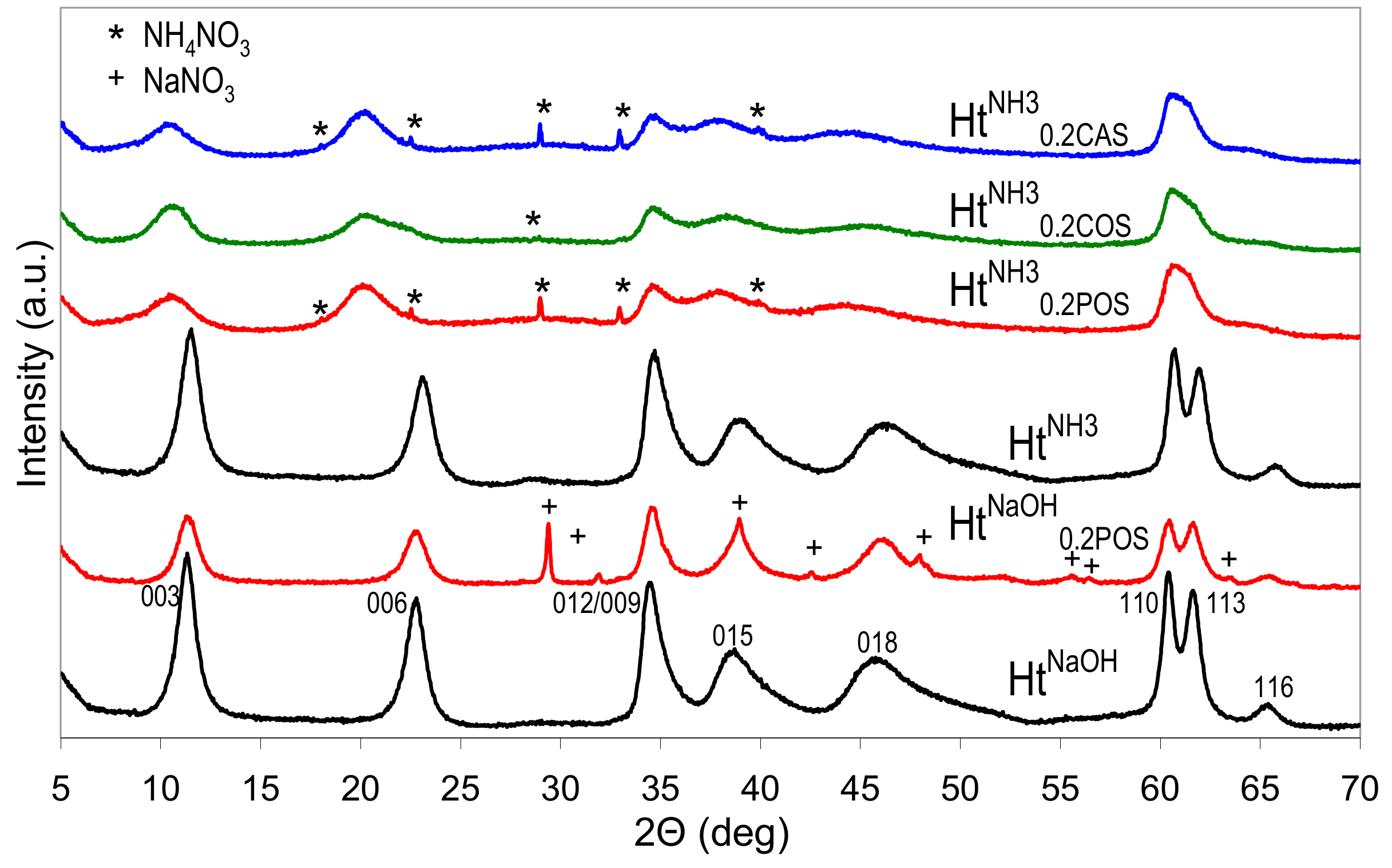
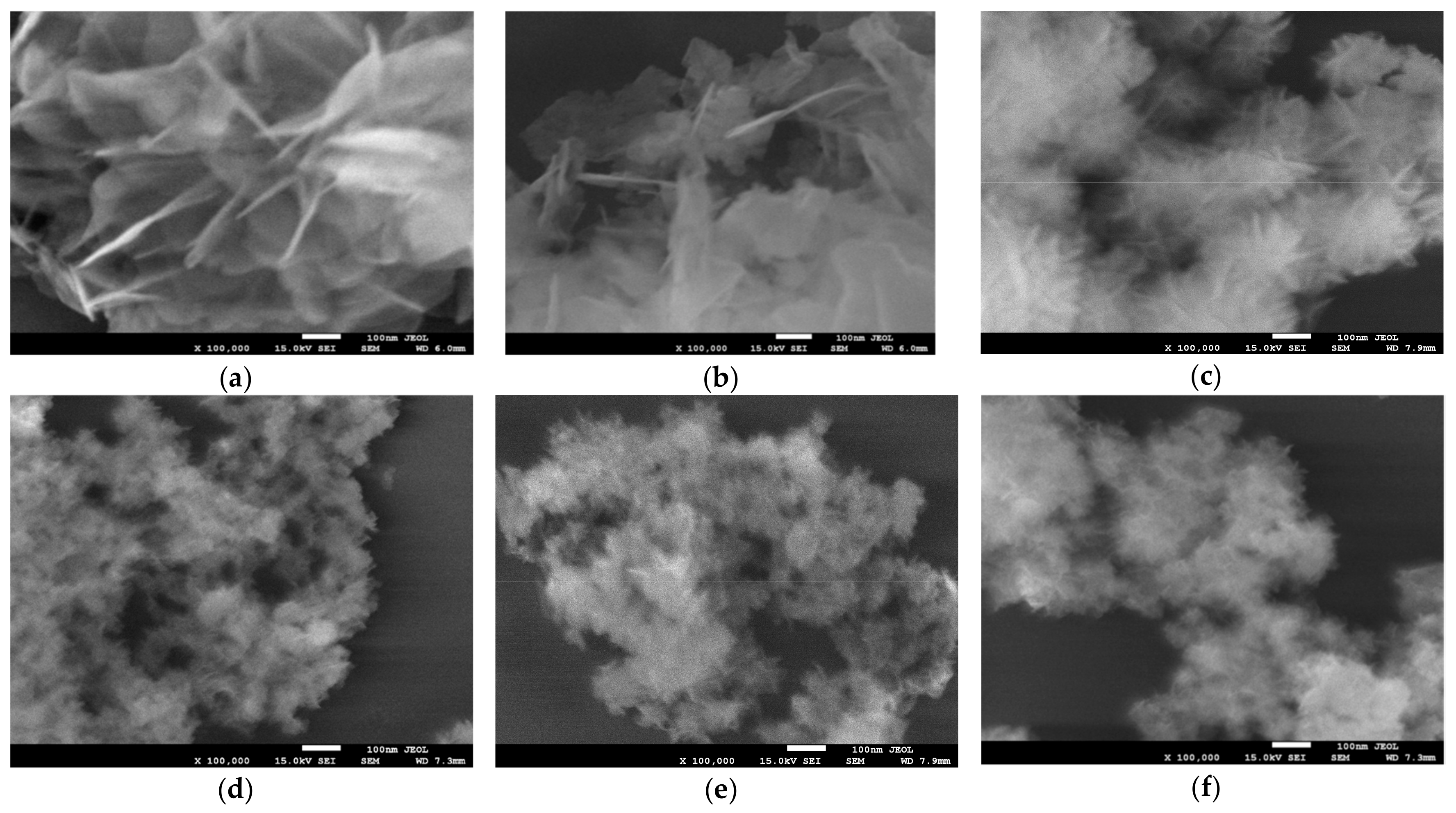
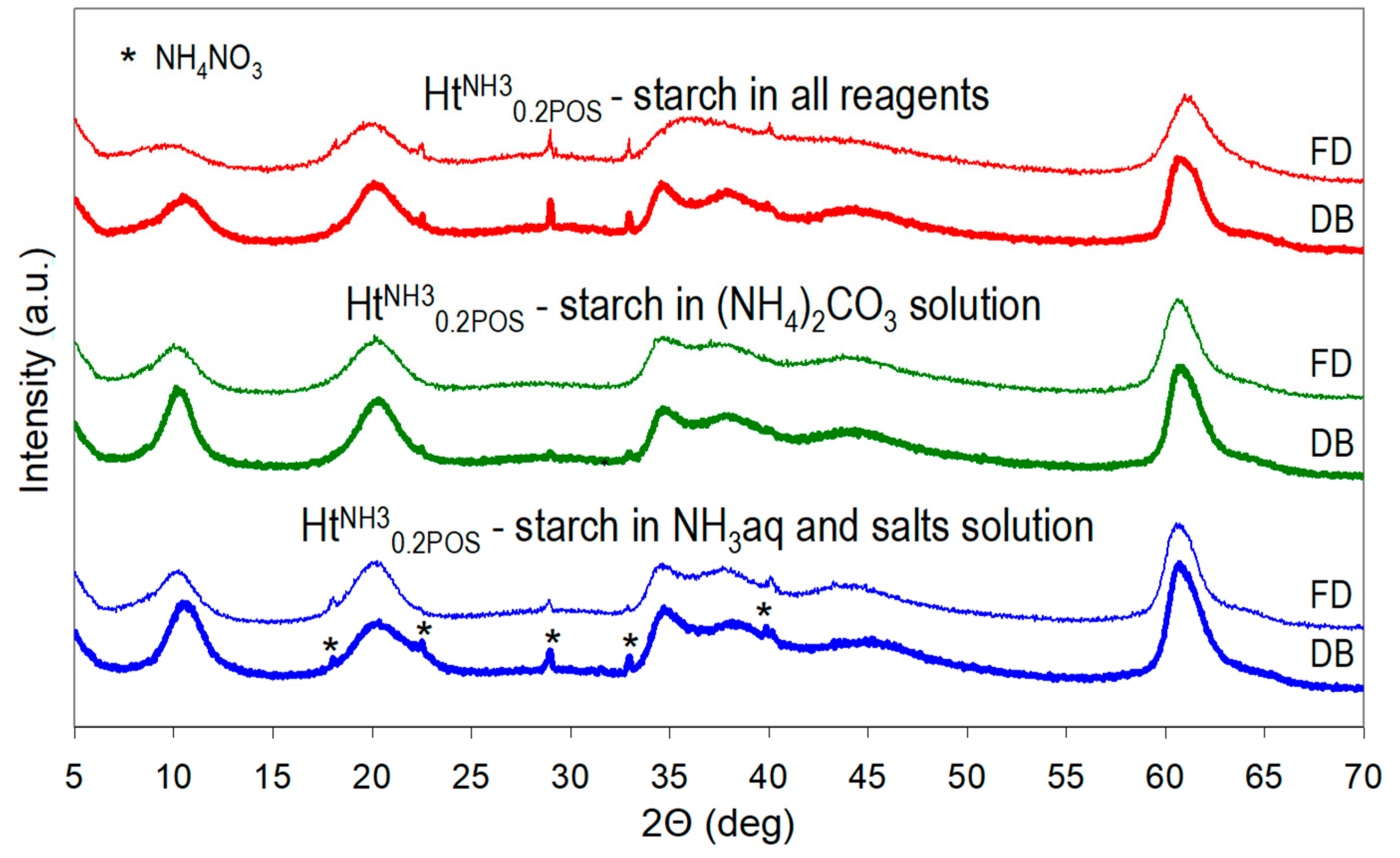
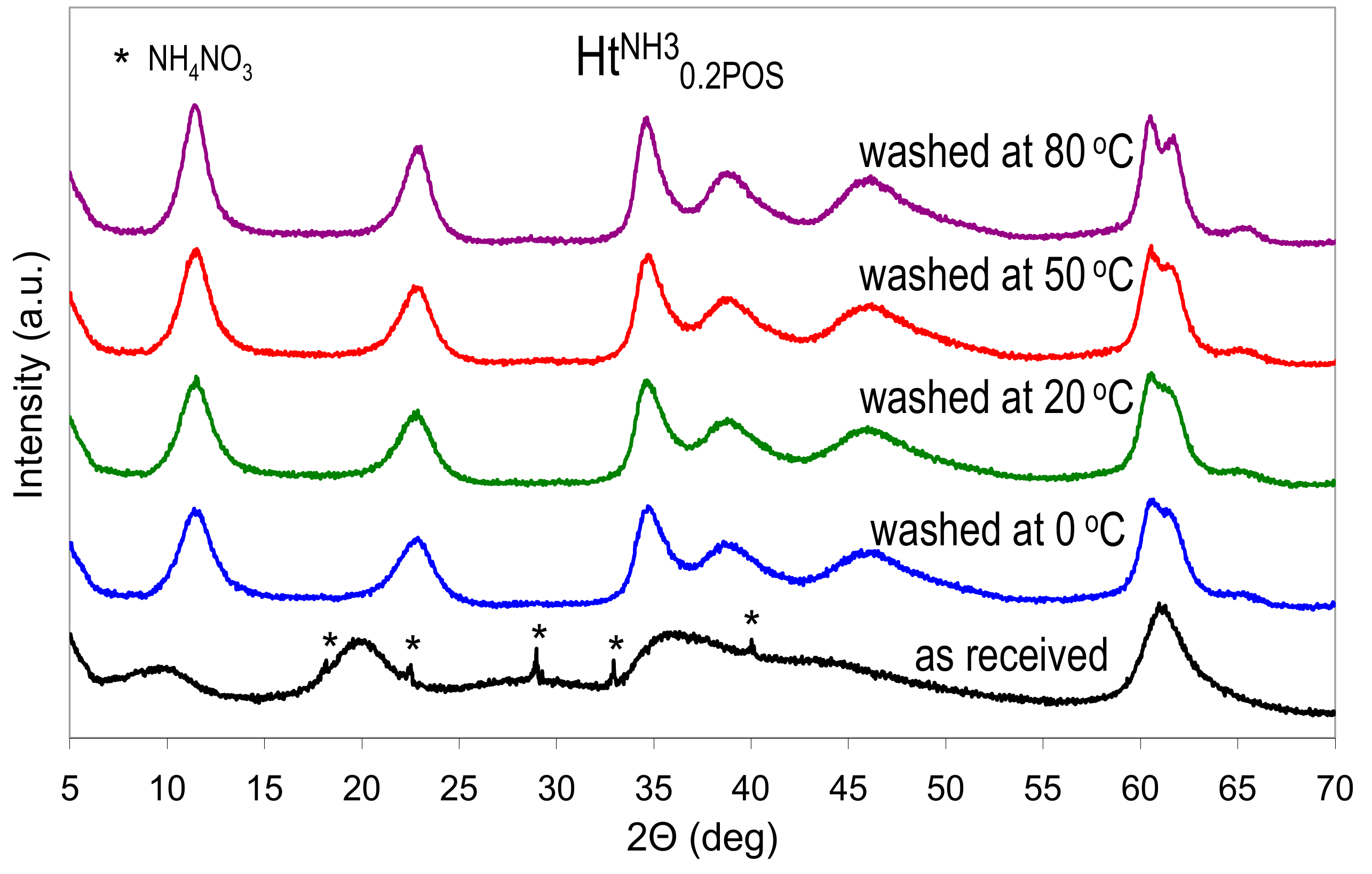
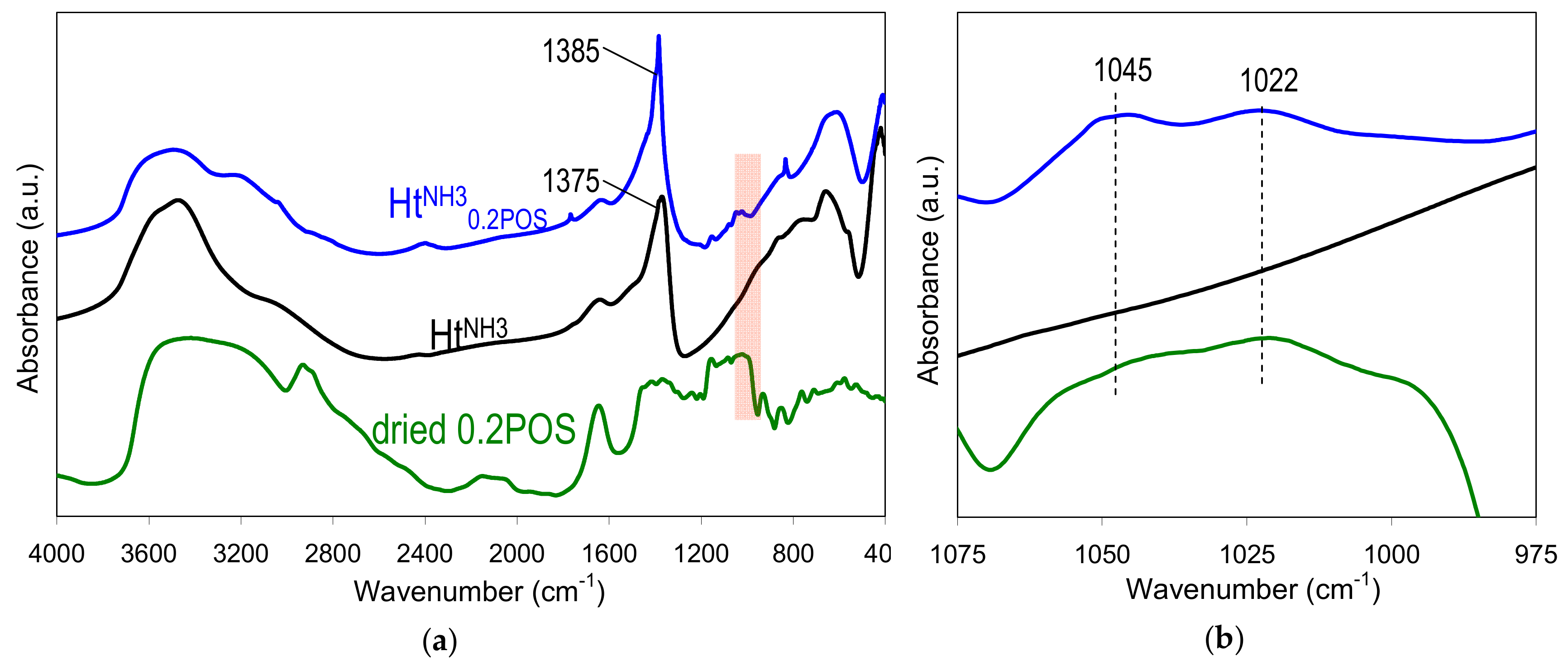
| Sample | Interplanar Spacing (nm) | Crystal Size (nm) | Mg/Al | ||
|---|---|---|---|---|---|
| d003 | d110 | D003 | D110 | ||
| HtNaOH | 0.780 | 0.1532 | 8.5 | 16.4 | 2.86 |
| HtNaOH0.2POS | 0.785 | 0.1533 | 7.0 | 12.6 | 2.92 |
| HtNH3 | 0.770 | 0.1526 | 7.2 | 14.7 | 2.59 |
| HtNH30.2POS | 0.842 | n.d. | 3.3 | n.d. | 2.80 |
| HtNH30.2COS | 0.836 | n.d. | 4.1 | n.d. | 2.77 |
| HtNH30.2CAS | 0.847 | n.d | 3.6 | n.d | 2.68 |
| Sample | d003 Interplanar Spacing (nm) | D003 Crystal Size (nm) | ||
|---|---|---|---|---|
| Drying Box | Freeze-drier | Drying Box | Freeze-drier | |
| HtNH30.2POS starch in all reagents | 0.842 | 0.897 | 3.3 | 2.8 |
| HtNH30.2POS starch in (NH4)2CO3 solution | 0.862 | 0.877 | 5.0 | 3.5 |
| HtNH30.2POS starch in NH4aq and in salts solution | 0.834 | 0.872 | 4.1 | 3.8 |
| Sample | Interplanar Spacing (nm) | Crystal Size (nm) | ||
|---|---|---|---|---|
| d003 | d110 | D003 | D110 | |
| HtNH30.2POS as received | 0.897 | n.d. | 2.8 | n.d. |
| HtNH30.2POS washed at 0 °C | 0.770 | 0.1530 | 4.2 | 8.4 |
| HtNH30.2POS washed at 20 °C | 0.769 | 0.1531 | 4.3 | 8.6 |
| HtNH30.2POS washed at 50 °C | 0.770 | 0.1530 | 4.8 | 8.8 |
| HtNH30.2POSwashed at 80 °C | 0.773 | 0.1531 | 5.6 | 10.2 |
© 2020 by the authors. Licensee MDPI, Basel, Switzerland. This article is an open access article distributed under the terms and conditions of the Creative Commons Attribution (CC BY) license (http://creativecommons.org/licenses/by/4.0/).
Share and Cite
Michalik, A.; Napruszewska, B.D.; Walczyk, A.; Kryściak-Czerwenka, J.; Duraczyńska, D.; Serwicka, E.M. Synthesis of Nanocrystalline Mg-Al Hydrotalcites in the Presence of Starch—the Effect on Structure and Composition. Materials 2020, 13, 602. https://doi.org/10.3390/ma13030602
Michalik A, Napruszewska BD, Walczyk A, Kryściak-Czerwenka J, Duraczyńska D, Serwicka EM. Synthesis of Nanocrystalline Mg-Al Hydrotalcites in the Presence of Starch—the Effect on Structure and Composition. Materials. 2020; 13(3):602. https://doi.org/10.3390/ma13030602
Chicago/Turabian StyleMichalik, Alicja, Bogna D. Napruszewska, Anna Walczyk, Joanna Kryściak-Czerwenka, Dorota Duraczyńska, and Ewa M. Serwicka. 2020. "Synthesis of Nanocrystalline Mg-Al Hydrotalcites in the Presence of Starch—the Effect on Structure and Composition" Materials 13, no. 3: 602. https://doi.org/10.3390/ma13030602
APA StyleMichalik, A., Napruszewska, B. D., Walczyk, A., Kryściak-Czerwenka, J., Duraczyńska, D., & Serwicka, E. M. (2020). Synthesis of Nanocrystalline Mg-Al Hydrotalcites in the Presence of Starch—the Effect on Structure and Composition. Materials, 13(3), 602. https://doi.org/10.3390/ma13030602





